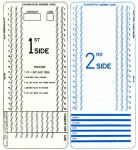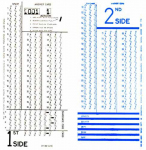Together with Terry Harris, Mark developed systems for computer marking and analysis of multiple choice question examinations in medical education, and for storing questions in a bank for repeat use. The service was eventually used by over 70 university departments.
| F.T.C.Harris, M.D.Buckley-Sharp (1968). Automation of multiple choice examination marking. British Journal of Medical Education, 2, 48-54. | Our first article describing computer assisted scoring (SCORE4) using single-sided 3-row mark-sense cards. Abstract |
| M.D.Buckley-Sharp, F.T.C.Harris (1968). Automation in Medical Education. In: Innovation and Experiments in University Teaching Methods, Institute of Education, University of London, April 1968. | Description and demonstration using SCORE6 and single-sided 5-row mark-sense cards as enabled by using IBM360 EBCDIC card codes. [No abstract]. |
| F.T.C.Harris, M.D.Buckley-Sharp (1968). MCQ and the Membership. Lancet, 1968-i, 245. | Discussion of the scoring system used by Royal College of Physicians. [No abstract]. |
| F.T.C.Harris, M.D.Buckley-Sharp (1968). Automated examination techniques. Lancet, 1968-i, 823. | Further discussion of the RCP scoring system, and reporting our progress elsewhere. [No abstract]. |
| F.T.C.Harris, M.D.Buckley-Sharp (1968). MCQ and the Membership. Lancet, 1968-i, 980. | Ongoing discussion of the RCP scoring system, with a comment about the merits of scoring for errors. [No abstract]. |
| M.D.Buckley-Sharp, F.T.C.Harris (1969). A System for the Automation of Multiple-Choice Question Examinations – Basic Details and Activity. In: Medical Computing, Ed M.E.Abrams, Chatto & Windus for the British Computer Society, 156-160. | Here we describe the development of our systems since 1965, comparing with others in the field. The service is offered to university teachers in over 30 departments, and many research areas have been opened up. [No abstract]. |
| F.T.C.Harris, M.D.Buckley-Sharp (1969). The use of the SCORE group of Programs. In: Medical Computing, ibid, 161-168. | A description of the SCORE version 6/360 program, with examples of the output and the purposes of the calculated results. [No abstract]. |
| M.D.Buckley-Sharp, F.T.C.Harris (1969). Marking Multiple-Choice Questions. Lancet, 1969-i, 205. | Further discussion of the RCP scoring system, and of the Glasgow scoring system (using both true and false option recording). [No abstract]. |
| M.D.Buckley-Sharp, F.T.C.Harris, J.B.Jepson, W.R.D.Smith, S.Walker (1969). The Evaluation of the Programmed Learning Course, British Journal of Medical Education, 3, 151-154. | Evaluation, with a control group, of a course in organic nomenclature for new entrants to two medical schools. Abstract |
| M.D.Buckley-Sharp, F.T.C.Harris (1969). Tapes/Slides or Lectures. Lancet, 1969-ii, 432. | Teaching methods need to be examined for efficiency and cost. [No abstract]. |
| M.D.Buckley-Sharp, A.N.Hamlyn, F.T.C.Harris (1969). The Use of Cluster Analysis to Group Examination Candidates. British Journal of Medical Education, 3, 225-231. | Introducing the concept that exams can group candidates as an alternative to merely ranking them. Candidates were here grouped on their scores, rather than on their raw response data as was done much later (unpublished 1993). Abstract |
| M.D.Buckley-Sharp (1969). The Automation of a National Research Project in Higher Education. In: Aspects of Educational Technology IV, Ed A.C.Bajpai, J.F.Leedham, Pitman Publishing, 255-263. | Includes pictures of our double-sided 5-row mark-sense card, and of a Lector optical mark-sense sheet design. Abstract |
| M.D.Buckley-Sharp, F.T.C.Harris (1970). The Banking of Multiple Choice Questions. British Journal of Medical Education, 4, 42-52. | Discusses why question banking is needed, with some of the basic requirements, and describes an implementation.Includes a picture of our manual Question Bank card which integrates with the computer filing system. Abstract |
| M.D.Buckley-Sharp, F.T.C.Harris, J.B.Jepson (1970). A Linear Educational Study on the Intake of a Single Year into Medical School. British Journal of Medical Education, 4, 89-96. | Reviews performance data on students from A-level through to the end of the first clinical year. Abstract |
| (in) B.Lennox, R.Lever (1970). Seminar on the machine marking of medical multiple choice question papers. British Journal of Medical Education, 4, 219-227. | Meeting report including contributions from the main research groups in the field, including by the Middx group. [No abstract] |
| (in) B.Lennox, A.A.C.Wallace (1970). The use of computers in assessment of medical students. Scottish Medical Journal, 15, 400-408. | Discussion of three main systems, including that of the Middlesex group. [Includes an unauthorised picture of our double-sided mark-sense cards] [No abstract] |
| M.D.Buckley-Sharp, F.T.C.Harris (1970). A computer program for banking multiple choice questions. The Computer Journal, 13, 230-236. | Technical description of the purpose, design, command language and implementation of our QBANK system. Abstract |
| M.D.Buckley-Sharp, K.Shendery, M.Hobsley, R.Marcusson (1971). Assessment of a revised course in surgery. British Journal of Medical Education, 5, 34-41. | A commissioned evaluation showing equivalence between two streams of teaching under a new curriculum. [No Abstract] |
| M.D.Buckley-Sharp, F.T.C.Harris (1971). The scoring of multiple-choice questions. British Journal of Medical Education, 5, 279-288. | Our definitive paper on scoring methodology, including the hypergeometric model for testing random performance and a review of all scoring methods in current UK use. Abstract |
| M.D.Buckley-Sharp, F.T.C.Harris (1972). Methods of analysis of multiple choice examinations and questions. British Journal of Medical Education, 6, 53-60. | Our definitive paper on examination and question analysis, including development of previous 1-from-n methodology into the general case. Abstract |
| M.D.Buckley-Sharp, F.T.C.Harris (1972). MINISCORE – A computer program for scoring Multiple Choice Tests and its relation to Self Learning Assessment Modules (SLAM). Int.J.Math.Educ.Sci.Technol, 3, 367-373. | Description of how our SCORE program was revised to facilitate direct student feedback, thus converting MCQ from a purely assessment method into a teaching method. Abstract |
| M.D.Buckley-Sharp, F.T.C.Harris (1972). An assessment of a final qualifying examination, British Journal of Medical Education, 6, 201-211. | Review of all parts of a final MB session, with suggestions arising from the analysis. Abstract |
| M.J.Stern, F.T.C.Harris, M.D.Buckley-Sharp (1972). Personality factors in medical and other students. British Journal of Medical Education, 6, 268-276. | Reporting the development of our systems to scoring and analysis of the 16PF personality factor inventory. Includes a picture of our double-sided TRIPLE card. Abstract |
| M.J.Stern, F.T.C.Harris, M.D.Buckley-Sharp (1973). Multiple-choice question paper scores in pathology. British Journal of Medical Education, 7, 10-15. | Review of pathology MB examinations set in schools of the University of London. Abstract |
| M.D.Buckley-Sharp (1973). A Multiple Choice Question Banking System. In: Computer Assisted test Construction, Educational Technology, 13-iii, 16-18. | Summary report of our question banking system. [No abstract] |
| M.D.Buckley-Sharp (1974). Departments of Medical Education. Journal of the Royal Society of Medicine, 67, 685-688. | Discussion of the required specification for such a department, with a summary description of our work. [No abstract] |
| L.J.Edouard, F.T.C.Harris, M.D.Buckley-Sharp (1976). Linear study of medical undergraduate performance. Medical Education, 10, 386-397. | Continuation of our earlier (1970) linear study to final qualification of the cohort. Abstract |
| M.D.Buckley-Sharp (1992). Assessment of Academic Performance and Personality. Medical Education, 26, 166. | Correspondence re published paper. [No Abstract] |
| (1) M.D.Buckley-Sharp (1993). The Principles of Numerical Taxonomy applied to Multiple Choice Question Examination Data, (unpublished) (2) M.D.Buckley-Sharp (1993). The Classification of Students in Two Multiple Choice Question Examinations by Numerical Taxonomy, (unpublished) | Commentary and Abstract |





